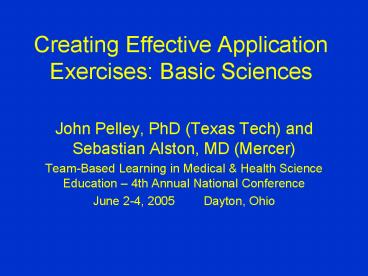Creating Effective Application Exercises: Basic Sciences PowerPoint PPT Presentation
1 / 21
Title: Creating Effective Application Exercises: Basic Sciences
1
Creating Effective Application Exercises Basic
Sciences
- John Pelley, PhD (Texas Tech) and Sebastian
Alston, MD (Mercer) - Team-Based Learning in Medical Health Science
Education 4th Annual National Conference - June 2-4, 2005 Dayton, Ohio
2
Three Part Agenda
- Presentation/exercise/discussion (TBL) format
- Where to begin Setting the appropriate learning
level (60 min) - Writing it up Composing good questions (40 min)
- Developing discipline Getting students to
cooperate (20 min) - (last minute addition) 10 min for evaluation
3
First A Few Trick Questions
- Talk with a neighbor about the following
statements (5 min). - Learning in teams
- throws the responsibility for learning on the
strongest students. (T/F) - emphasizes application and memorization. (T/F)
- is highly variable among students and hard to
control. (T/F)
4
What Are The Ways Of Knowing?
- Evaluation What is predicted? clinical
treatment and management - Inference What is concluded? diagnosis
- Comparison How are patterns related?
- Analysis How are facts grouped into patterns?
- Recall Just the facts maam
- (Each level uses the ones below it.)
- (see page 8 in handout)
5
Learning Objectives Examples
- Evaluation Develop a treatment plan for a type
2 diabetic. - Inference Justify your diagnosis of type 2
diabetes. - Comparison Explain how type 1 and type 2
diabetes are different. - Analysis Give the characteristics of type 1
diabetes. - Recall Define hyperglycemia, ketoacidosis,
glycosylation
6
Memorization vs. HOTS
- Memorization
- Recall
- Higher Order Thinking Skills
- Analysis
- Comparison
- Inference
- Evaluation
- All five levels can be appliedbut
- Recall used in clinical procedures/protocols
- HOTS used in clinical problem solving
7
Fundamentals For TBL Exercises
- Problem oriented learning requires a specific
decision. - A decision requires a rationalea guess is not a
rationale! - A rationale is reasoning that utilizes memorized
information. - Types of rationales
- Similarities, differences, groupings,
cause-and-effect relationships
8
Dialogue Linear Thinking vs. Integrative
Thinking
- Both linear and integrative learning are
important - Linear facts and specifics
- Integrative patterns and relationships
9
Designing A TBL Exercise
- Start at the end the application exercise
- HOTS questions are essential
- One case vs. several cases time factor
- Step 1 (in handout, page 1)
- Too few is better than too many
- Three application question sets per hour
- 2-3 hour time blocks total
- 50 of time in application exercise
- Sample Case Application Question (page 2)
10
- A 74 year old female has come to your office
suffering from hyperventilation, malaise,
dizziness, and muscle pains. She was diagnosed
with Type 2 diabetes at the age of 50 and has
managed her disease successfully with diet,
exercise, and hypoglycemic agents. She was
initially put on a hypoglycemic agent called an
oral sulfonylurea (chlorpropamide), but recently
was switched to metformin which is better
tolerated in the elderly. Her blood pH is 7.2 and
her serum lactate is 10X normal levels. Her
creatinine clearance and serum creatinine
concentrations indicate diminished renal
function.
11
Long Answer Choices
- This patient has a blood pH of 7.2 because
- ketones from excess fat mobilization are making
her blood acidic. - increased glycolysis and reduced TCA cycle
activity leading to excess lactate formation. - hypoxia resulting from inhibition of electron
transport is creating excess carbon dioxide. - increased blood sugar increasing glycolysis and
lactate production in red blood cells.
12
Or, Short Answer Choices
- Metformin action in the production of lactic
acidosis is most analogous to which of the
following? - Fluoride
- Pentachlorophenol
- Cyclic AMP
- Oligomycin
13
Barriers
- You dont know everything about the clinical
aspectsor, - You dont know how to integrate other disciplines
(handout page 7, also TBL Collaborative). - Hard to find people that can help.
- Time consuming to look things upcan you trust
the internet?
14
Group Exercise 1
- Utilizing templates to formulate higher order
questions (10 minutes group, 20 minutes
discussion) - Directions are on the exercise handout.
15
Group Exercise 2
- Developing a sensitivity to the quality of the
questions (10 minutes group, 15 minutes
discussion). - Greatest opportunity for dialogue and problem
solving? - Integrative knowledge vs. memorized knowledge
16
Group Exercise 3
- Developing a sensitivity to the quality of the
answers (rational alternatives). (10 minutes
group, 15 minutes discussion) - Lead in Which of the following is the best way
to correct her elevated pulse rate? - Greatest problem solving challenge?
- Emphasis on HOTS rather than memorization
17
Composing Good Questions
- Sample supporting materials Handout page 4
- Learning objectives reading assignments
- Supplementary information
- Resources for faculty Handout page 5
- Question templates
- Sources of case vignette questions
- Question formats
- Stick with Type A questions.
- Long answers are OK, but not too ambiguous
18
Core Knowledge RATs and Learning Objectives
- Steps 2 and 3 in handout
- RATs can have HOTSor not.
- RATs should be relevant derived from
- application exercise answer choices
- patient data in case vignette
- RATs are not comprehensivebut objectives are!
- Objectives should be relevant derived from RAT.
19
HOTS Level
- Which of the following would NOT produce lactic
acidosis? - Carbon monoxide poisoning
- Impaired gluconeogenesis
- Impaired pentose phosphate shunt
- Impaired pyruvate oxidation
- Cyanide poisoning
20
Memorization Level
- The rate of glycolysis is increased by
- glucose 6-phosphate.
- fructose 2,6 bisphosphate.
- citrate.
- lactate.
- acetyl-CoA
21
Getting Students To Cooperate
- (time permitting)
- Simultaneous reporting of teams
- Inter-group discussions management
- Answer-challenging methods
- Tell me about your thinking
- Evaluate the exercise

